FEATURED STORY How phantom forests are used for greenwashing 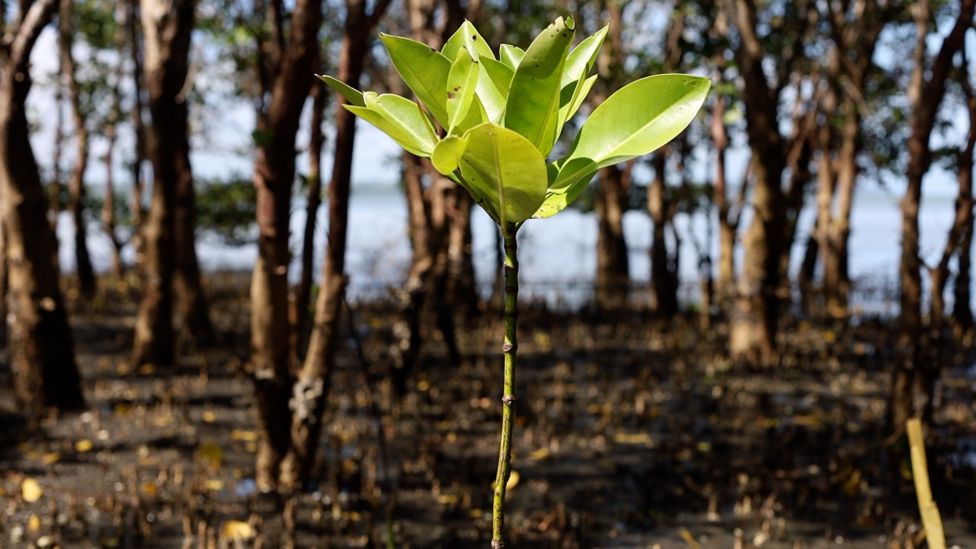 PHILIPPINES – Capturing carbon by increasing forest cover has become central to the fight against climate change. But there’s a problem. Sometimes these forests exist on paper only – because promises have not been kept, or because planted trees have died or even been harvested. A new effort will now be made to track success and failure. Dr Jurgenne Primavera is being paddled in a canoe along the coast of Iloilo in the Philippines. It’s an idyllic scene but she is frowning. Six years ago these shallow waters were planted with mangroves as part of the country’s ambitious National Greening Programme, but now there is nothing to see but blue water and blue sky. Ninety per cent of the seedlings died, Dr Primavera says, because the type of mangrove planted was suited to muddy creeks rather than this sandy coastal area. The government preferred it, she suggests, because it is readily available and easy to plant. “Science was sacrificed for convenience in the planting.” READ MORE Global 6 Reasons for Restoring and Protecting Mangroves
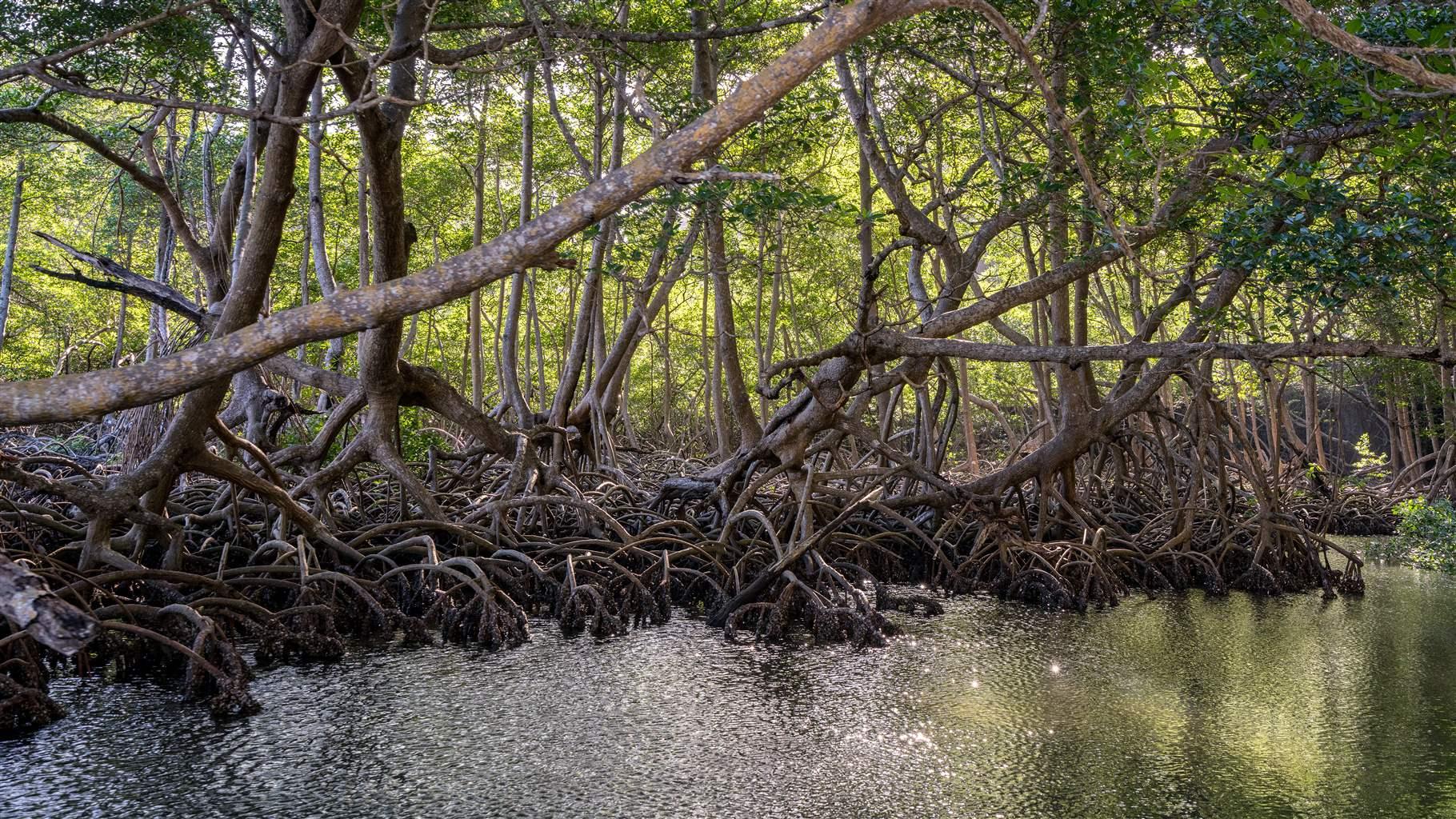
GLOBAL – Governments around the world that are seeking to fight climate change while providing other significant benefits to ecosystems and coastal communities should consider protecting and restoring mangrove forests. Like seagrasses and salt marshes, mangroves are coastal wetlands that serve as nursery and feeding grounds for a broad range of species, storm buffers for communities, and highly efficient carbon sinks—a big draw for countries looking to implement nature-based climate action. Yet, despite the numerous benefits that mangroves provide, they are some of the most threatened ecosystems on Earth. Experts estimate that half of the world’s mangroves have been lost in the past 50 years because of habitat destruction, coastal development, and pollution. It’s little surprise that mangroves are teeming with life: These forests are ideal nursery grounds for many marine fish, including grouper, snapper, and some shark species, as well as invertebrates that find food and shelter among the submerged roots. Vast numbers of fish, mollusks, clams, oysters, crabs, birds, and other animals make their homes amid mangroves, creating an ecosystem abundant with food for animals as well as humans. READ MORE Faunal Marvels Of The Mangrove
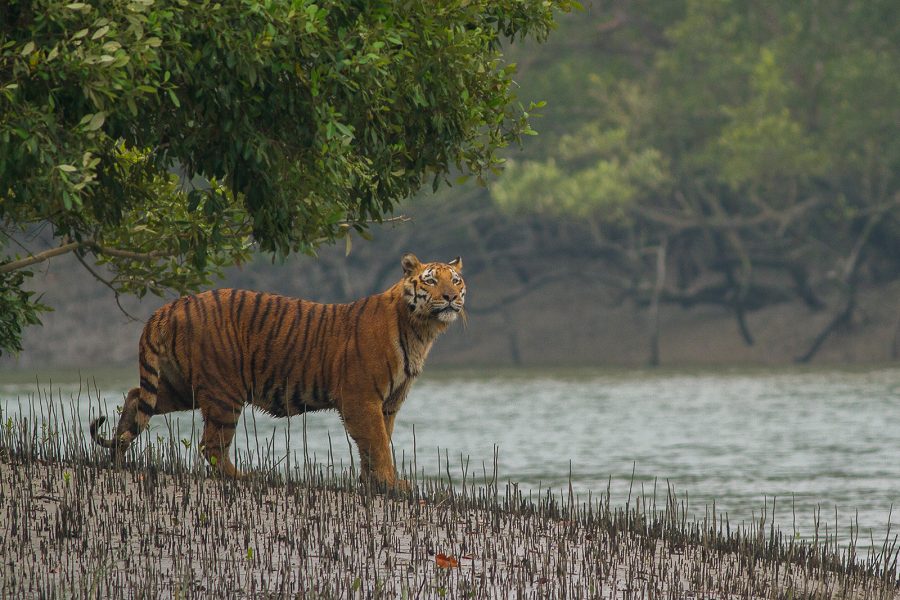
GLOBAL -Mangrove forests mostly consist of trees and shrubs growing in intertidal areas (where land meets the sea). What is unique about these forests is that they can be classified under more than one category of coastal ecosystems: estuary and tidal marsh. The meandering rivers running through these regions form a vast and complex network, whereby they mix with saltwater and form estuaries. These brackish estuarine ecosystems are lined with mangrove vegetation. Mangroves can also be classified as tidal marshes, which are coastal ecosystems shaped by the tidal movement of saltwater. The scale of ecosystem services which mangrove forests provide is widely underestimated. These forests ensure carbon sequestration, livelihoods and protection against coastal erosion, storms and cyclones. In India, mangroves are found in Maharashtra, Goa, the Andaman and Nicobar islands, and West Bengal. This forest is a peculiar home for its inhabitants due to the harsh weather conditions, dense foliage and the constant ebb and flow of water it offers. Hence, we find some of the toughest and most fascinating animals living in India’s mangroves. These include the largest reptile on Earth, the fish that walks on land and the only mangrove tiger! READ MORE AFRICA Niger Delta mangroves in ‘grave danger’ from oil spills, poverty, invasive species

NIGERIA – Of the delta’s diverse resources, it’s the oil and gas deposits that are most attractive to the Nigerian state and extractive corporations, as it was for British colonizers a century ago. Nigeria reportedly has 206 trillion cubic feet of natural gas reserves, and the world’s 10th-largest reserve of crude oil, amounting to around 25 billion barrels. Oil contributed 7.24% of Nigeria’s GDP in 2021, and oil exports continues to dominate the country’s foreign exchange earnings. Growing evidence, however, suggests that the pursuit of oil is at the heart of irreversible ecosystem damage affecting people and mangroves alike. In the past decade alone, there were more than 8,636 oil spill incidents, which released a combined 385,909 barrels of oil into the surrounding environment, according to data from Nigeria’s National Oil Spill Detection and Response Agency (NOSDRA). The ongoing spills, regulatory agencies say, are a result of leaks from old and unserviced pipelines, as well as artisanal oil refining operations. Significant leaks also come from oil “bunkering,” a form of oil theft in which pipelines are punctured and oil illicitly diverted to unauthorized destinations. This diverted crude, known as “dirty fuel,” is refined and sold in Nigeria’s booming black market. READ MORE One of World’s Most Polluted Spots Gets Worse as $1 Billion Cleanup Drags On
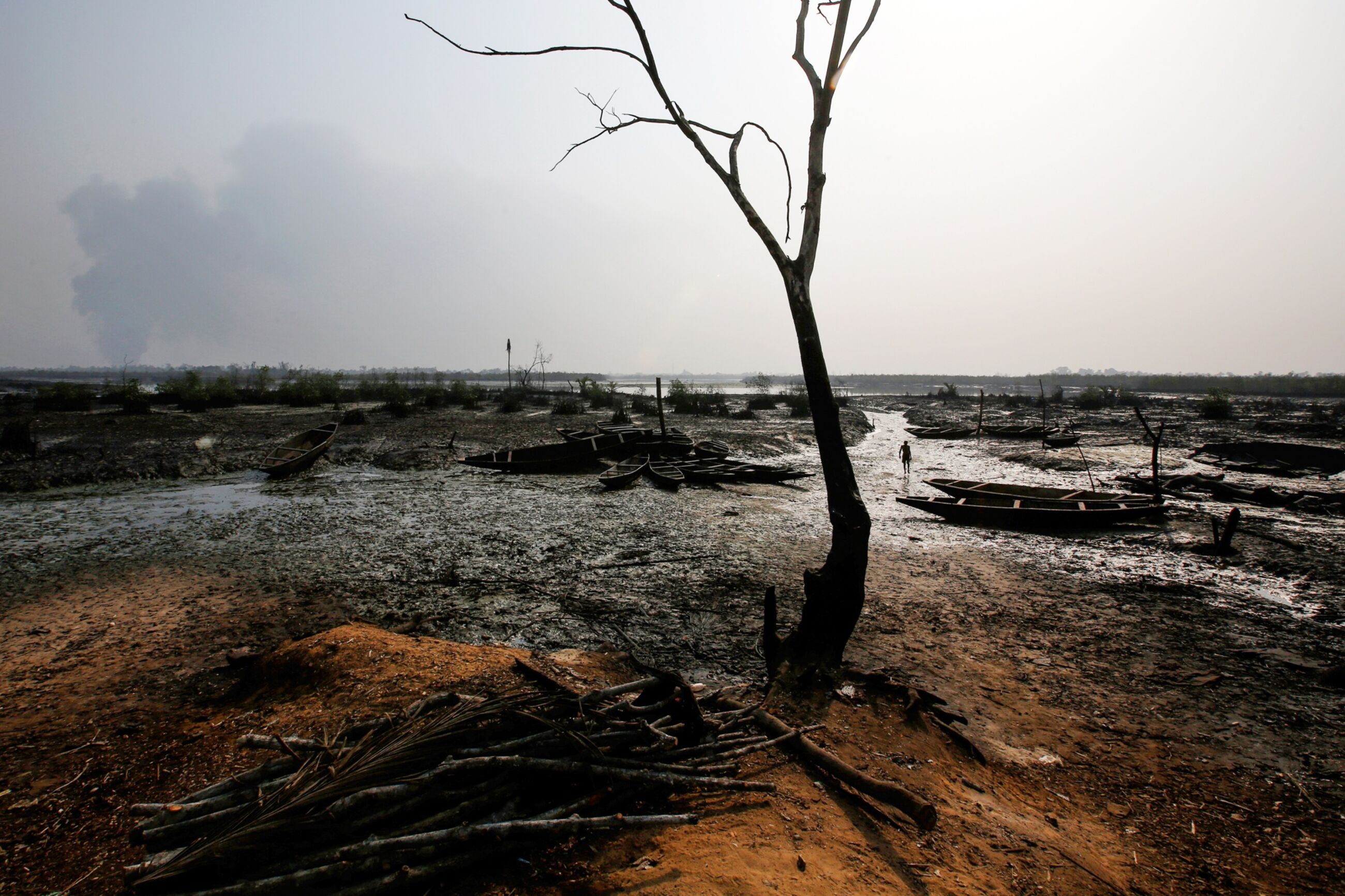
NIGERIA – In the more than a quarter century since Shell Plc left Ogoniland in southern Nigeria, oil has continued to ooze from dormant wellheads and active pipelines, leaving the 386-square mile kingdom’s wetlands shimmering with a greasy rainbow sheen, its once-lush mangroves coated in crude, well-water smelling of benzene and farmlands charred and barren. So when the $1 billion Ogoniland cleanup began in 2019, backed by Shell’s funding pledge and support from the United Nations, it was heralded as the most ambitious initiative of its kind anywhere in the world. But now, UN Environmental Programme documents seen by Bloomberg and reported for the first time indicate that the project — far from being exemplary — is making one of the earth’s most polluted regions even dirtier. “We had hoped that the Ogoniland cleanup process would set the standard for the cleanup that will have to take place in the Niger Delta as a whole,” said Mike Karikpo, an Ogoni attorney with Friends of the Earth International. “But we’ve not seen any impact. There ought to be some impact on the lives and livelihoods of people whose lands and rivers were impacted by this oil.” READ MORE AMERICAS How Can Mangroves Help Turn the Tide Against Climate Change?

BAHAMAS – When Lindy Knowles thinks back to his childhood in the Bahamas, a particular tree is the backdrop of his best memories: the mangrove. Spindly, with twisted roots, mangroves thrive in tidal areas around the islands, including a creek near his grandmother’s house. Knowles learned to fish among the forests, which are home to conch, lobsters, and a variety of fish; he learned to swim in the calm waters around the trees, their roots buffering him from ocean waves. For a kid like Knowles, mangroves meant adventure. “It was just part of my upbringing,” he says. For coastal communities like those in the Bahamas, mangroves mean stability and protection. They’re a safe harbor for hundreds of creatures. And they help protect communities from threats associated with climate change, including worsening storms, rising sea levels, and erosion. They’re important for those living far from a coastline, too: Mangrove forests are an important tool in combatting climate change. Compared with other forests, the mangrove ecosystem has a superior ability to store carbon, and that can help slow the warming of the planet. READ MORE Three Million Dollar Mangrove Restoration Marching Toward Completion
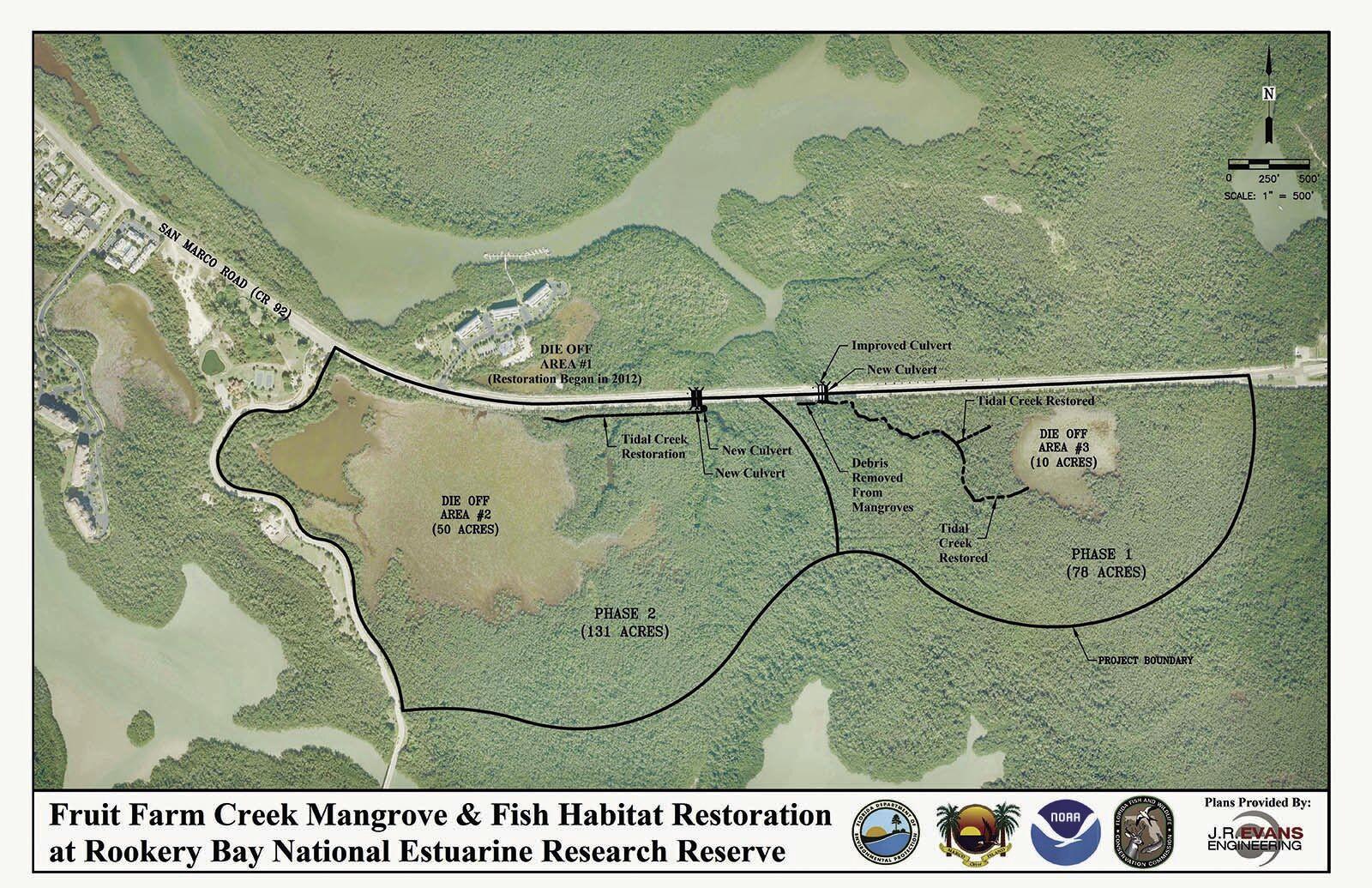
USA – You may want to plan on short delays when driving to or from the Goodland area during the next couple of months as Florida’s largest ever mangrove restoration project enters its final stages. The huge Fruit Farm Creek Mangrove project kicks into high gear on eastern San Marco Drive as four five-foot diameter culverts are installed under San Marco Road, restoring tidal flow to 209 acres of mangrove forest that abut the road. “They’re at full speed,” said Corey Anderson, project manager and restoration biologist for the Florida Fish and Wildlife Conservation Commission (FWC). “There have been delays. We’ve got the City of Marco Island subcontractor, Quality Enterprises, out there. They are beginning to do the heavy construction. They completed their relocation of the underground utilities. It took them a couple of months. They had to drill under the highway, put in some new pipe. What took a long time was getting the health department to sign off on it. That put us behind a little bit. It’s not out of the ordinary for municipalities to do.” READ MORE Students taking part in mangrove study, planting project

USA – The Sanibel-Captiva Conservation Foundation reported that environmental educator Richard Finkel has initiated a year-long mangrove study and planting project with eighth-graders at The Sanibel School in Florida. Over the past month, the students collected red mangrove propagules found washed up along local shorelines, and they recently potted 200 of the seedlings in one-gallon containers. “Mangrove seeds germinate while they are still on the tree, a process known as vivipary, which gives them a head start in the growing process over traditional fallen seeds,” Finkel said. During the school year, the students will monitor mangrove growth in different salinity concentrations, soil substrates, and amounts of sunlight and conduct research studies. They will then have the opportunity to present the results of their research to biologists at the SCCF’s Marine Laboratory. At the end of the year, the students will take part in a community mangrove planting project with Coastal Watch, which has been restoring mangrove habitats across Sanibel and the Pine Island Sound. READ MORE $20 million federal grant awarded to USF for coral reef and mangrove ecosystem protection

USA – The National Science Foundation awarded USF with a $20 million grant to the university’s lead team of researchers. The money will be used to develop a standardized approach to both the replenishment and protection of coral reef and mangrove ecosystems. Civil and Environmental Engineering Professor Maya Trotz will lead the team. “I think it was in 2014 when I first started taking students internationally to Barbados and Belize. We have to go see the reef, we have to snorkel. We have to see that beauty on what it is we are trying to protect,” said Maya Trotz, Civil and Environmental Engineering Professor at the University of South Florida. The grant will focus on the coral reef ecosystems near Miami, Belize and the U.S. Virgin Islands. “It allows us to continue to do research and to support our mission to train students to be globally competent to be community engaged to do projects that actually have some sort of societal impact,” said Trotz. READ MORE ASIA The Western Indian Ocean lost 4% of its mangroves in 24 years, report finds

INDIA – A new analysis of satellite data finds the Western Indian Ocean region lost around 4% its mangrove forests over the past quarter-century. In a report that discusses the state of these mangroves, the authors write that their findings provide decision-makers with the high-quality, reliable data they need to protect these threatened coastal forests. Published July 2022 by Wetlands International, the International Union for the Conservation of Nature (IUCN) and the World Wildlife Fund (WWF), the report focuses on mangrove coverage in Kenya, Tanzania, Madagascar and Mozambique, which together account for 5% of the world’s mangroves. The report is based on analysis of satellite data collected by online monitoring platform Global Mangrove Watch (GMW) and builds on a 2020 global report. It is the first of several studies that will look more closely at what can be done to restore mangroves in specific regions, says Paul Erftemeijer, an independent marine scientist and one of the report’s authors. READ MORE The reality of saving young mangroves in the Sundarbans

INDIA – A 700 to 800 metres stretch of mangroves to the west of Pakhiraloy ferry ghat on an island in the Indian Sundarbans, part of a plantation project in 2020, was reportedly washed away by the Gomor river in March this year. At another 1,200-1,300 metres stretch right next to it, part of the same project, the mangroves survived the waves, but not the grazing pressure from cattle. As stipulated by the authorities, the plantation had been protected with nylon nets to keep cattle away. However, only scant traces of those barriers were found during Mongabay-India’s visit. The mangroves had grown up to two to three feet tall, but local communities said that the plantations looked only as thick as when they were planted first. “Many of the trees that have survived now, may not last another couple of years if cattle grazing is not restricted, and fresh barricades of nylon nets are not put up,” local resident Jogesh Mondal told Mongabay-India. READ MORE Indigenous belief systems bolster mangrove reforestation in Palawan
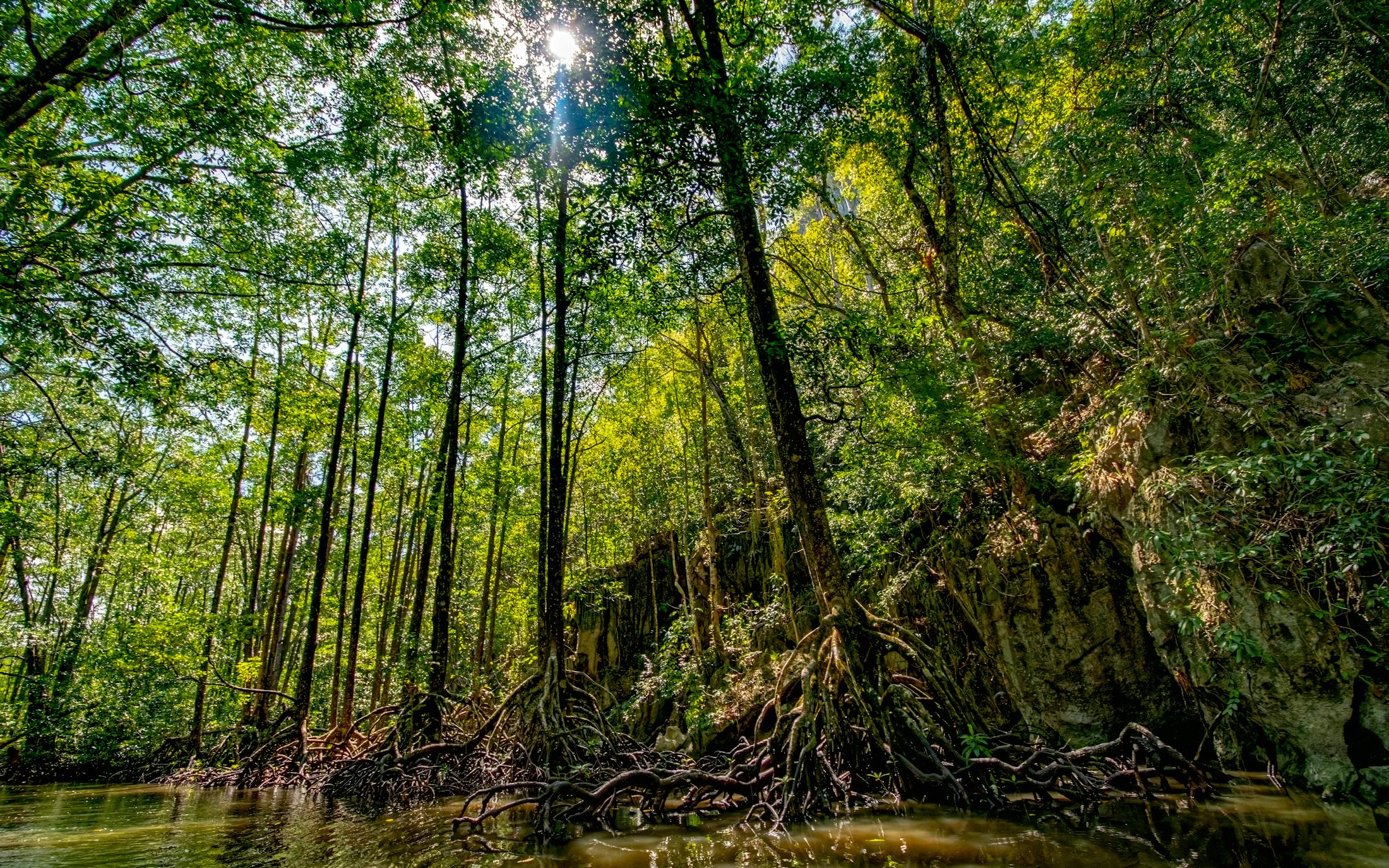
PHILIPPINES – In the middle of the brackish water of Malampaya Sound in the Philippines’ Palawan province, Panchito Calamare stands on an outrigger fishing boat one drizzling May morning, slowly pulling in his crab line and removing one by one the day’s haul. When he returns home, he hands over the crabs to his wife, Gloria, to weigh. Other fishermen also come to sell their catch to the couple. Within an hour, their regular buyer arrives to collect the catch, which will eventually land in restaurants and hotels across the province. The couple recognise that their bountiful catch is tied to the thick mangroves blanketing the sound’s coast. “We take care of our mangroves. We don’t cut them down, because it’s where the crabs and fishes spawn,” says Panchito, 53, from the Indigenous Cuyunon group. “That’s also why we make sure other people won’t destroy them.” Sitting in the shade of a nipa hut, 44-year-old Gloria faces a mangrove forest while weaving a fishing net. “The mangroves are really a big help to us,” she says. She observes that the crabs inhabit the mangroves until they mature, move to the sea, and are caught by fishers like them. READ MORE Digital mangrove planting becomes strategy for developing blue economy
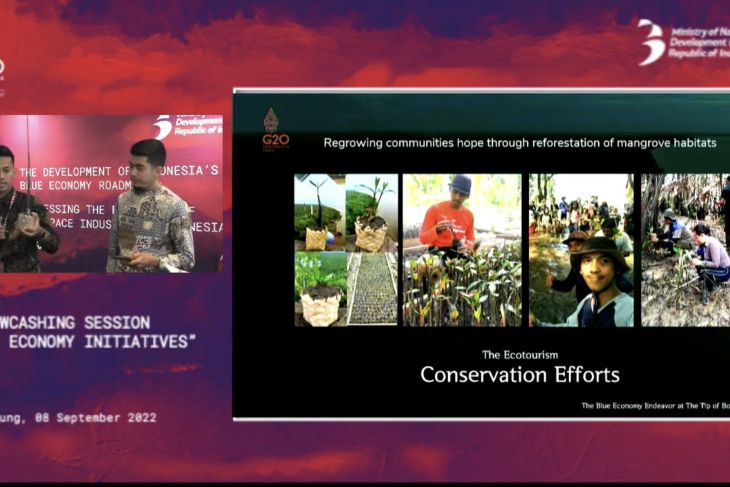
INDONESIA – Digital mangrove planting tourism conducted by the community in Sungai Kupah Village, Kubu Raya District, West Kalimantan, has become a strategy for developing the blue economy. At the G20 Development Ministerial Meeting (G20 DMM) event titled “Showcasing Session of Blue Economy Initiatives in Belitung” held on Thursday, one of the groups that presented its efforts related to the blue economy is the Digital Mangrove Planting Tourism, led by Rudi Hartono. “Digital mangrove planting is where tourists can plant (mangroves) in our tourist site, and we will (provide) the coordinates of the tree (location),” Hartono remarked. He explained that Sungai Kupah is a coastal village by Natuna Sea, and there is a mangrove forest that forms into a fortress that protects the village.Unfortunately, during the period from 2000 to 2017, the mangrove forest was affected by abrasion, thereby making the village prone to high waves and floods. This condition drove Hartono and young people in the village to innovate to improve the mangrove ecosystem that can provide added value to the local economy at the same time. “We have been discussing abrasion in this village since 2017 until we have a joint commitment to conducting the reforestation of our mangrove forest,” he explained. Hence, he launched the digital mangrove planting activity wherein tourists can plant mangroves either on-site or through the committee. READ MORE Like this newsletter?
 Pease consider donating to MAP to keep it going.
Giving could never be easier  *Articles in this newsletter may mention practices being used and/or show exagerated results being claimed without proof. Stories are presented here in effort to show mangrove related activity around the world and do not necessarily reflect Mangrove Action Project’s views or mangrove restoration best-practices. | NOTICE
Mangrove Macrobenthos Managament Conference MMM6 Colombia 2023
On behalf of the Organizing Committee of the MMM6, we want to announce that MMM6 organizers are working to hold the conference in the last week of July 2023 in Cartagena de Indias. We hope to make the official launch very soon. We invite you to follow them on twitter @MeetingMmm6
ACTION ALERTS Do not sacrifice Congo’s rainforests to the oil industry! TAKE ACTION TAKE MAP SURVEY Please see the survey questionnaire we at MAP put together to discover where the shrimp industry is still having major adverse effects on mangroves and local communities.
TAKE THE SURVEY Stop the Dredging – 6.7 million cubic meters of sand from the Addu atoll basin will destroy nature, biodiversity and the natural defences and resilience of this UNESCO Biosphere Reserve. SIGN THE PETITION Keep fossil fuels out of Bangladesh for the health and wellbeing of the local communities, the beautiful regional beaches and forests, the Bangladeshi economy, and our shared climate. SIGN PETITION Stop this total madness Stop the biggest heated oil pipeline in the world — right through the heart of Africa!
CLICK HERE
Like this newsletter? Pease consider donating to MAP to keep it going. Giving could never be easier 
MAP Website en Español
haga clic aqui 13 Year old Linda Li “Mangrove Adventure” from Kid Dream Art School

WATCH NOW 
Restoring The Natural Mangrove Forest
Watch movie

Community Based Ecological Mangrove Restoration in Rufiji Delta VIEW VIDEO
Video: Mangroves for the Future
View Here WANT TO GET INVOLVED?
Follow and Join MAP!    
Like this newsletter? Pease consider donating to MAP to keep it going. Giving could never be easier 

Interested in connecting or working with MAP? Check out our opportunities here 
MANGROVE ISSUES Want to learn more about mangroves?
Our short presentation will give you a better understanding of the issues we are working to solve. WATCH PRESENTATION What is CBEMR? Download MAP’s 2 page CBEMR Information Sheet containing links to all MAP’s CBEMR resources – CLICK HERE View MAP’s uploaded Videos at
MAP Video Gallery Question Your Shrimp Consumer/Markets Campaign!
WATCH VIDEO Mangroves: Guidebook to Malaysia – Click Here SHARE MAP’S VISION
CLICK HERE to watch short introductory video. Together we can work “at the roots of the sea”. Our short documentary, Reducing the Risk of Disaster through Nature-Based Solutions : Mangroves 
NASA Study Maps the Roots of Global Mangrove Loss
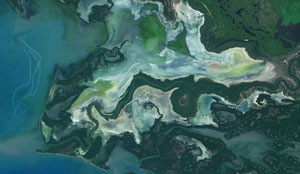
Marvellous Mangroves Curriculum The Marvellous Mangroves Curriculum begins with a simple philosophy – getting future generations to not only learn about, but understand the importance of mangrove forests. VISIT 
The award-winning Marvellous Mangroves (MM) curriculum educates children on the importance of mangroves and their ecological functions, teaching them about modern challenges and mechanisms for sustainability. VIEW VIDEO Marvellous Mangroves Curriculum in Bangladesh – WATCH VIDEO
MARVELLOUS MANGROVES IN BRAZIL
En Portuges 
Marvellous Mangroves – A Curriculum-Based Teachers Guide.
Like this newsletter? Pease consider donating to MAP to keep it going. Giving could never be easier 
“Question Your Shrimp” Campaign Question Your Shrimp – is it really sustainable? Sign the Petition
Note to Our Readers: We strive to keep active links in our newsletter. However, due to circumstances beyond our control, occasionally links to stories may become broken. If you find a link to a story is not functioning, please cut and paste the headline into your browser search bar. In most cases you should be able to locate the original story.
Not yet a MAP News subscriber?
Click here to subscribe. 
*Articles in this newsletter may mention practices being used and/or show exagerated results being claimed without proof. Stories are presented here in effort to show mangrove related activity around the world and do not necessarily reflect Mangrove Action Project’s views or mangrove restoration best-practices.
|





























